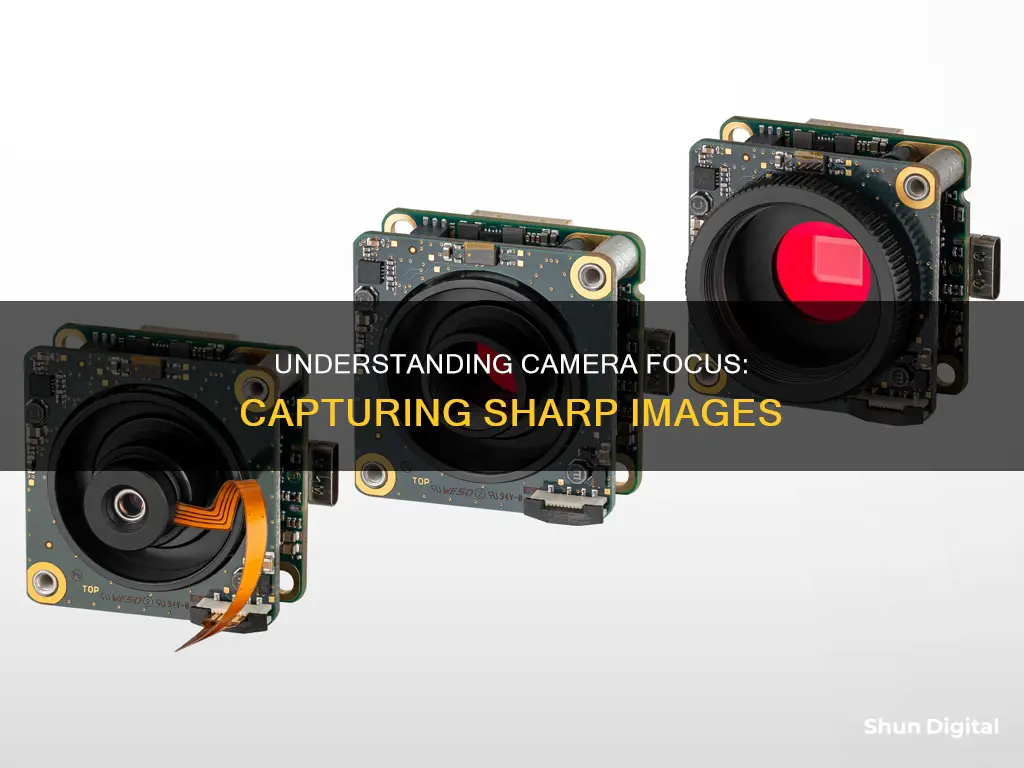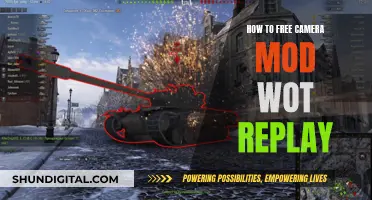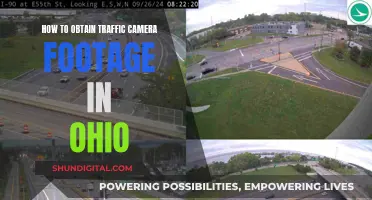
Focusing is a fundamental technique in photography. It involves adjusting the lens to highlight the sharpest area of an image, bringing the desired subject into focus. The focus can be adjusted manually by turning a ring or wheel on the lens or automatically by the camera system. Modern cameras use autofocus, which first appeared on the market in 1977, to make the process easier and faster. Autofocus systems use a motor in the camera or lens to focus on a subject, either manually selected or automatically chosen by the camera.
What You'll Learn

Manual vs. autofocus
Autofocus (AF) is when the camera system drives a motor to move elements in your lens to change focus. Autofocus systems use a motor in the camera or lens to focus on a subject you’ve selected manually or automatically.
Manual focus, on the other hand, is when you, the user, set the point of focus in your image by turning a ring or similar mechanism on the lens.
When to use autofocus
Most photographers use autofocus more often than manual focus. The main reason is simply convenience; it’s easier than focusing manually. Autofocus is also faster and, in many cases, more accurate (such as tracking focus on a moving subject). This is why sports and wildlife photographers tend to rely on autofocus so heavily.
When to use manual focus
Manual focus is useful when your camera is having trouble focusing, such as in dark conditions, or when you want to make precise adjustments that the camera may have missed. You can also use manual focus to lock focus for a series of photos in a row.
Manual focus is also useful when shooting in low-contrast scenes, in low-light conditions, or in scenes with many objects, as autofocus systems rely on contrast to identify objects of interest and can be confused by foreground objects.
Manual focus is also very well-suited to macro photography, as it is precise and easy to use to pick out objects of interest from a chaotic scene.
The pros and cons of autofocus
Autofocus is generally faster and more accurate than manual focus, especially when tracking moving subjects. However, it can struggle in low-light conditions or when there are many objects in the scene.
The pros and cons of manual focus
Manual focus gives you complete control over the focus of your image, which can be useful in certain situations such as macro photography or portrait photography, where precise focus is required. It can also be useful when shooting through glass or wire fences, as autofocus can get confused about where to focus. However, manual focus requires more time and skill to get right, especially when shooting moving subjects.
Understanding Sleep Mode on Zmodo Cameras
You may want to see also

Active vs. passive autofocus
There are two types of autofocus (AF) systems: Active and Passive. The Active AF system works by transmitting an ultrasonic or infrared signal towards the subject. The distance between the camera and the subject is then calculated by measuring the time it takes for the signal to bounce back. This system is useful in low-light environments but is only effective for stationary, non-moving subjects and those that are positioned close to the camera.
On the other hand, the Passive AF system works by detecting contrast. There are two types of Passive AF: Phase Detection and Contrast Detection.
Phase Detection
Phase Detection AF is commonly found on DSLR cameras. It works by dividing the incoming light into pairs of images and comparing them. The distance between these images is measured to determine whether the object is in front or back focus. This information is then used to adjust the lens and bring the object into focus. Phase Detection AF is very fast, making it ideal for tracking fast-moving subjects.
Contrast Detection
Contrast Detection AF is commonly used by mirrorless cameras, point-and-shoot cameras, and DSLR cameras in live view mode. It works by scanning the scene and rapidly changing focus from foreground to background until the subject is in focus. Contrast Detection AF tends to be slower than Phase Detection but is more reliable in low-light conditions.
While most modern DSLR and mirrorless cameras can use both Phase and Contrast Detection to acquire focus, some cameras combine these two methods in a Hybrid AF system to achieve faster and more accurate results.
Doorbell Camera Battery Options: External Power Source?
You may want to see also

Phase detection autofocus
The autofocus sensor contains two or more image sensors with microlenses above them. These tiny sensors create the camera's autofocus points. The first passive autofocus cameras used to have one central focus point, whereas modern cameras can have dozens of selectable focus points.
The phase-detection system is very fast and good at tracking moving subjects since it doesn't require much computational work from the camera. However, it is more prone to errors and internal misalignment issues. Some cameras let you calibrate your phase detection system to minimize errors.
The process of phase detection autofocus can be summarised as follows:
- The light that passes through the extreme sides of the lens is evaluated by two image sensors.
- Based on how the light reaches the image sensors, the autofocus system can determine if an object is front or back focused and by how much.
- The autofocus system then instructs the lens to adjust its focus.
- The above steps are repeated as many times as needed until perfect focus is achieved. If focus cannot be achieved, the lens resets and starts reacquiring focus, resulting in focus "hunting".
- Once perfect focus is achieved, the autofocus system sends a confirmation that the object is in focus (e.g., a green dot inside the viewfinder, a beep, etc.).
Locking Camera Focus: A Guide to Mastering Sharp Photography
You may want to see also

Contrast detection autofocus
This is similar to how our brains work when we use manual focus. We look at edges and move the focus ring back and forth until the edge contrast is the sharpest.
However, it is important to note that contrast detection autofocus uses more power than phase detection autofocus. This is because the lens motor moves more with contrast detection autofocus, and larger lenses with multiple glass elements will move more slowly.
In summary, contrast detection autofocus is a simple, accurate, and affordable autofocus technology. It is ideal for static subjects and situations where speed is not a priority, such as still life or landscape photography.
Japan Camera Import: Customs and Charging
You may want to see also

Continuous vs. single-servo autofocus
When it comes to autofocus, there are two main modes: continuous-servo and single-servo autofocus. Continuous-servo autofocus is ideal for photographing moving subjects. In this mode, the camera continuously adjusts focus as long as you hold down the focusing button. This is also known as AI Servo (Canon) and AF-C (Nikon).
Single-servo autofocus, on the other hand, is best suited for situations where both the subject and the camera are completely still. Once the camera achieves focus in this mode, it will not readjust until you release the focusing button and try again. This mode is also referred to as One-Shot (Canon) and AF-S (Nikon).
Some cameras also offer a third mode, Auto-Servo Autofocus, which automatically switches between continuous and single-servo autofocus depending on the scene. However, it is still important to understand the differences between the two main modes to ensure the camera doesn't make a mistake when selecting the autofocus mode.
In addition to selecting the autofocus mode, photographers also need to choose the autofocus area mode, which tells the camera which focusing strategy to use. Common autofocus area modes include Single-Point autofocus, Dynamic autofocus, 3D Tracking autofocus, Group-Area autofocus, and Auto-Area autofocus.
XR Night Mode Camera: Is It Possible?
You may want to see also
Frequently asked questions
Focus is the sharpest area of the image. It is the area where the lens works to highlight an object, a person, or a situation. It is one of the pillars of photography, along with ISO, aperture, and shutter speed.
Autofocus is a camera setting that makes the focusing process easier, especially for beginners or those who want to experiment with a type of photography that requires more speed. The camera system drives a motor to move elements in your lens to change focus.
If you are using a wide-angle lens (28mm or wider), it is safe to say that if everything in the photograph is at least 50 feet away, you don't have to worry about depth of field, and you can focus anywhere in the frame. With a 50mm lens, this "safe" distance is about 100 feet. With a 100mm lens, it's more like 250 feet.
A lens can only be in one focal position at a time. So, if the objects are at different distances from the camera, you can't focus on them all at once. If your depth-of-field is reasonably deep, this might not be a problem. If you are using a shallow depth-of-field, you will need to be more specific about what to focus on.







